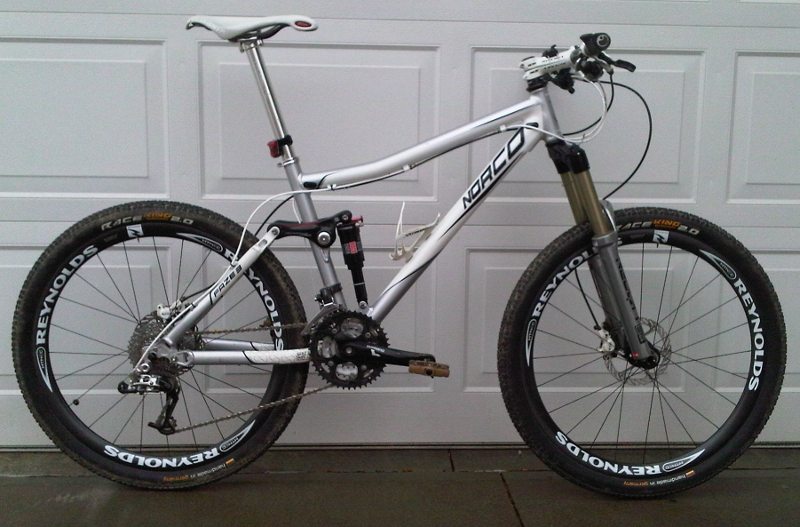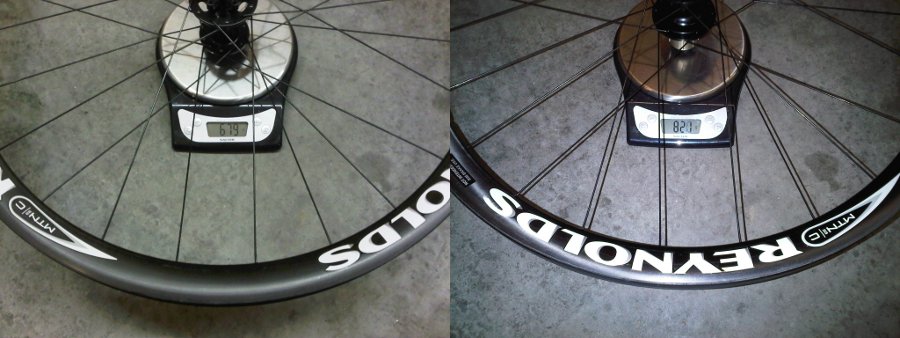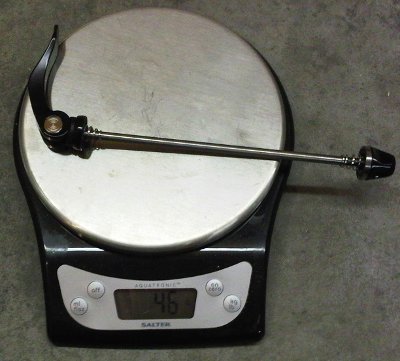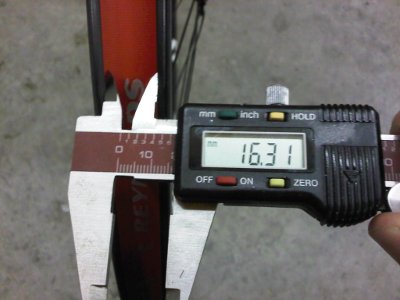
2010 Reynolds MTN-C Carbon Wheelset Review

My performance in the 2010 Bicycle World Black Oak Internet Time Trial (held at nearby Black Oak Park) had me convinced that my Norco Faze, as good as it was, still wasn't quite up to snuff. In particular, I had on it a set of heavy WTB wheels that had come off my 2005 Giant Yukon, swapped on because I wanted to keep all the MTB wheels in our family stable on Schraeder valvestems, to enable tube interchangeability on rides.
Besides, those wheels weighed the same as the wheels that came OEM on the Faze 3, so there was no compelling reason to go one way or the other save for the valvestem size. The Norco wheels went on the Giant (subsequently sold) and the WTBs went on the Faze. Shortly thereafter, my wife bought a Faze 3 of her own and kept the OEM Presta wheels, and my cunning plan went for naught.
Besides the minor annoyance that now my bike was the only bike we owned on Schraeders, the Black Oak Time Trial showed that I was pretty much at my limit on the bike as it sat. A large portion of that limit was my own fitness - although I was in the best shape of my recent life during that event, neither was I capable of maintaining a full sprint through the whole course. As that course is primarily a series of fast corners (sprint to the corner, slow down to make the turn, sprint to the next) a lot of my energy was being spent constantly re-accelerating the bike. Heavy wheels act as flywheels, and resist acceleration. Lighter wheels would reduce the amount of energy needed to get back up to speed, and should theoretically translate into more energy later in the ride at the same speeds, meaning that performance should drop less as I stay fresher, longer.
I've always been curious to see just how much weight loss on the bike translates into actual performance. When you consider the weight of the bike (somewhere between 20-35 lbs, depending on model and budget) and the weight of me (210-235 lbs, depending on season) it is far easier (and cheaper) to drop weight from me than from the bike. But then, weight is weight, and rotating weight hurts more than static weight... it's tough to tell just from the math. The only way to know is through experiment.
And besides, who doesn't like bling?
So the plan was to get a set of light wheels. I had my eye on a set of Stan's NoTubes, which can be had in the 1500-1600 gram range for a reasonable cost.
And then Jenson USA had an end of season sale on the Reynolds MTN-C carbon wheels.
Normally, carbon wheels would never be on my radar. While stronger, lighter, and stiffer than aluminum wheels, they are also several times more expensive. A set of Zipp 404 clincher wheels for my road bike costs more than a set of Enkei racing wheels for my friggin' car. While not quite that expensive, the MSRP on the Reynolds wheels is still more than 95% of most of the complete bikes at Bicycle World. There's just no way I could ever justify spending that much money on a set of bicycle wheels.
But when the closeout sale at Jenson drops the price to cheaper than the Stan's wheels... God help me I just couldn't resist.

This is how much each wheel weighed, including the rim strip. The rims themselves are matte finish carbon; without the stickers they wouldn't be very blingy at all. The hubs are apparently DT Swiss 240, badged as Reynolds. The rear freehub has a very crisp and precise sound to it, like a precision watch mechanism. The section depth of the rim means the height of a standard Presta valvestem won't stand proud of the rim, meaning you can't get a pump head on it - Reynolds thoughtfully provides a pair of valve stem extenders so the tires can be inflated, as well as a set of plastic tire levers.
The Conti Race King 2.0 tires mounted without any fuss. The rims made a very different crackly-plastic sound as the bead set, which was a little scary, but the tires took less air to mount than they had needed with the WTB rims.

Reynolds provided wheel skewers as well.

This is the inside width of the wheel.

By comparison, here are the weights of the OEM wheels. As you can see, the carbon wheels are WAY lighter. The weight savings is (heh) MASSIVE.
With the snow too deep to ride, I took the bike out to Joyride 150, an indoor mountain bike skills park in north Toronto.
I am not a light dude. I'm ~213 lbs in fighting trim, and after a holiday season with too many goodies and nowhere near enough cardio, I'm... somewhat north of that number at this point. After four hours of assaulting the Joyride XC loop and a few kicks at the rock garden and skinnies, the wheels were still straight, true, and tight.
The immediately obvious difference was that that bike accelerates MUCH quicker out of corners. A couple of quick kicks and the bike was immediately up to speed. This isn't a subtle difference; it's more of a "Holy crap!" moment the second you jump on the throttle. If you are wondering how much of a difference lightweight wheels really makes, the answer is "a whole lot".
Notwithstanding though, the ride at Joyride wasn't enough to really provide a definitive review. To be honest, the "terrain" at Joyride is nothing like my usual trails and I was outside my comfort zone for a large chunk of the session, so I don't have a good baseline for comparison. To do that, I'm going to have to try these wheels at Black Oak in the spring.
I've now had a chance to run these wheels on actual trails... and the difference in the bike is spectacular. The amount of energy it takes to spin up to speed is a fraction of what it was before, and in many cases, I'm finding the limiting factor in how fast I can go is not so much my fitness level, but the layout of the track itself. The difference in acceleration is incredible.
These wheels made the single biggest difference of all the upgrades I have made to this bike. More of my energy is being translated into forward motion, and less being lost in overcoming inertia.
Black Oak hasn't dried out enough yet to make the Time Trial course fully rideable, but I'm positive that I'm going to break the 20 min barrier this year - and these wheels will be a big part of that.
As far as durability goes, the wheels are holding up just fine. They don't crackle any more when airing up a new tire, and they still run straight and true. The spokes, though, are super light gauge (they look like piano wire) and while they are fine for normal loads (even hard cornering and jumps) I got a stick caught in the rear wheel and it popped a spoke like a guitar string.
Then you get to deal with the fact that, while the spoke is a normal "J" spoke, not some oddball thing like a Crank Bros Cobalt, few bike shops stock the super-light spokes in MTB sizes. And on top of that, to repair the spokes (or true the wheel) you have to dismount the tire and rim strip to get at the spoke nipple.
It would be worthwhile to keep a small supply of spokes and hex nipples handy, because your average LBS just won't have them in stock.
The valve stem extensions have proven to be annoying as well, as they don't want to seal up unless you use Teflon plumber's tape on the stem threads. I've taken to using long-stem tubes, which only seem to come in 1.00"-1.25" thicknesses. Given that I'm running tires that are 1.75" to 1.9" wide, I'm currently getting away with this, but I wish I could find a 1.75" tube with a 60mm valvestem on it.
